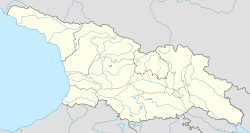Borjomi
| Borjomi ბორჯომი |
||
|---|---|---|

Overlooking Borjomi amid the Lesser Caucasus
|
||
|
||
| Location of Borjomi in Georgia | ||
| Coordinates: 41°50′0″N 43°23′0″E / 41.83333°N 43.38333°E | ||
| Country |
|
|
| Mkhare | Samtskhe-Javakheti | |
| Population (2014) | ||
| • Total | 10,546 | |
| Time zone | Georgian Time (UTC+4) | |
Borjomi (Georgian: ბორჯომი) is a resort town in south-central Georgia with a population of 10,546. It is one of the districts of the Samtskhe-Javakheti region and is situated in the northwestern part of the region in the picturesque Borjomi Gorge on the eastern edge of the Borjomi-Kharagauli National Park. The town is famous for its mineral water industry (which is the number one export of Georgia), the Romanov summer palace in Likani, and the World Wide Fund for Nature-site Borjomi-Kharagauli National Park. Borjomi mineral water is particularly well known in those countries which were part of the former Soviet Union; the bottling of mineral water is a major source of income for the area. Because of the supposed curative powers of the area's mineral springs, it is a frequent destination for people with health problems. Borjomi is also home to the most extensive ecologically-themed amusement park in the Caucasus.
In the Middle Ages, the area of what is now Borjomi was part of the Tori province. It was populated by a series of forts guarding the strategic crossroad of routes leading to the western, eastern, and southern provinces of Georgia. Three important forts – those of “Gogia”, “Petra”, and “Sali” – still overlook the town from nearby hills. From the 16th century into the 19th, the area belonged to the noble family of Avalishvili, but was largely depopulated as a result of Ottoman inroads.
After the Russian annexation of Georgia, the Borjomi area began to revitalize. The toponym Borjomi is first recorded in the 1810s. The town and its surroundings were placed under the Russian military authorities. Borjomi began receiving soldiers in the 1820s. Buildings and baths began going up in the 1830s. Early in the 1840s, when the Russian Viceroy of the Caucasus Yevgeni Golovin brought his daughter down to partake of the cure, he expedited the official transfer of the waters from the military to civil authorities. The viceroy Mikhail Vorontsov, fascinated by local landscape and mineral waters, made Borjomi his summer residence and refurnished it with new parks. Its warm climate, mineral water springs, and forests made Borjomi a favorite summer resort for the aristocracy, and gave it its popular name of "the pearl of Caucasus". In the 1860s, new hotels were built, and an administration for mineral waters was established. In 1871, Borjomi was bestowed upon the royal family member, Grand Duke Mikhail Nikolayvich, then the viceroy of the Caucasus. In the 1890s, Mikhail’s son, Nikolay, built a park and a chateau at Likani, at the western end of Borjomi. The bottled mineral waters began to be extensively exported. The town grew significantly at the expanse of Russian migrants and, in 1901, the number of ethnic Russian inhabitants (2,031) outstripped the native Georgians (1,424) for the first time.
...
Wikipedia



